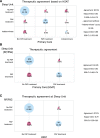Primary care and sleep unit agreement in management decisions for sleep apnea: a prospective study in Spain
- PMID: 32279702
- PMCID: PMC7970609
- DOI: 10.5664/jcsm.8492
Primary care and sleep unit agreement in management decisions for sleep apnea: a prospective study in Spain
Abstract
Study objectives: Involvement of primary care teams in the care of patients with OSA is a focus of interest. The study objective was to compare diagnostic and therapeutic agreement between decisions taken by primary care professionals and sleep unit specialists.
Methods: This was a prospective multicenter study conducted at primary care and specialized care centers in the urban area of Barcelona, Spain. Men and women aged 18-75 years who visited the participating primary care centers for any reason were recruited. Both primary care physicians and sleep specialists made a diagnostic and therapeutic decision with clinical data and results of a home sleep apnea test. All patients were finally assessed with respiratory polygraphy or polysomnography as a gold-standard test.
Results: A total of 229 patients underwent a home sleep apnea test and were evaluated at the primary care centers and the sleep units. Diagnostic agreement using the same tools and excluding indeterminate decisions was 69.8% (Cohen's kappa = 0.64; 95% confidence interval, 0.56-0.72). Agreement for therapeutic decisions (PAP vs conservative treatment) was obtained in 82.5% of patients (Cohen's kappa = 0.62; 95% confidence interval, 0.51-0.73), increasing to 92.5% (Cohen's kappa = 0.49, 95% confidence interval, 0.40-0.58) when indeterminate options were excluded. As compared with the final therapeutic decisions made at the sleep unit with respiratory polygraphy/polysomnography, primary care physicians agreed regarding 83.3% (Cohen's kappa = 0.62; 95% confidence interval, 0.49-0.74) of patients.
Conclusions: Primary care professionals may assume an important role in the management of OSA in coordination with sleep centers, identifying patients who require specific treatment and should be referred to specialized care.
Clinical trial registration: Registry: ClinicalTrials.gov; Name: PASHOS Project: Advanced Platform for Sleep Apnea Syndrome Assessment; URL: https://clinicaltrials.gov/ct2/show/NCT02591979; Identifier: NCT02591979.
Keywords: primary care; sleep apnea; sleep unit.
© 2020 American Academy of Sleep Medicine.
Figures



Comment in
-
Primary care and sleep unit agreement in management decisions for sleep apnea: a methodological issue to avoid misinterpretation.J Clin Sleep Med. 2020 Sep 15;16(9):1629. doi: 10.5664/jcsm.8518. J Clin Sleep Med. 2020. PMID: 32347207 Free PMC article.
-
Author response.J Clin Sleep Med. 2020 Sep 15;16(9):1631. doi: 10.5664/jcsm.8634. J Clin Sleep Med. 2020. PMID: 32501208 Free PMC article.
References
Publication types
MeSH terms
Associated data
LinkOut - more resources
Full Text Sources
Medical
Research Materials

